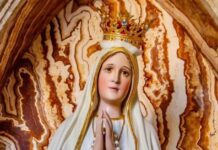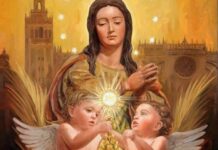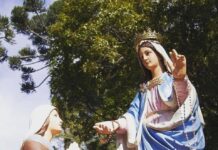226. Although this devotion is essentially an interior one, this does not prevent it from having exterior practices which should not be neglected. “These must be done but those not omitted.” If properly performed, exterior acts help to foster interior ones. Man is always guided by his senses and such practices remind him of what he has done or should do. Let no worldling or critic intervene to assert that true devotion is essentially in the heart and therefore externals should be avoided as inspiring vanity, or that real devotion should be hidden and private. I answer in the words of our Lord, “Let men see your good works that they may glorify your Father who is in heaven.” As St. Gregory says, this does not mean that they should perform external actions to please men or seek praise; that certainly would be vanity. It simply means that we do these things before men only to please and glorify God without worrying about either the contempt or the approval of men.
I shall briefly mention some practices which I call exterior, not because they are performed without inner attention but because they have an exterior element as distinct from those which are purely interior.
1. Preparation and Consecration
227. Those who desire to take up this special devotion, (which has not been erected into a confraternity, although this would be desirable), should spend at least twelve days in emptying themselves of the spirit of the world, which is opposed to the spirit of Jesus, as I have recommended in the first part of this preparation for the reign of Jesus Christ. They should then spend three weeks imbuing themselves with the spirit of Jesus through the most Blessed Virgin. Here is a programme they might follow:
228. During the first week they should offer up all their prayers and acts of devotion to acquire knowledge of themselves and sorrow for their sins.
Let them perform all their actions in a spirit of humility. With this end in view they may, if they wish, meditate on what I have said concerning our corrupted nature, and consider themselves during six days of the week as nothing but sails, slugs, toads, swine, snakes and goats. Or else they may meditate on the following three considerations of St. Bernard: “Remember what you were – corrupted seed; what you are – a body destined for decay; what you will be -food for worms.”
They will ask our Lord and the Holy Spirit to enlighten them saying, “Lord, that I may see,” or “Lord, let me know myself,” or the “Come, Holy Spirit”. Every day they should say the Litany of the Holy Spirit, with the prayer that follows, as indicated in the first part of this work. They will turn to our Blessed Lady and beg her to obtain for them that great grace which is the foundation of all others, the grace of self-knowledge. For this intention they will say each day the Ave Maris Stella and the Litany of the Blessed Virgin.
229. Each day of the second week they should endeavour in all their prayers and works to acquire an understanding of the Blessed Virgin and ask the Holy Spirit for this grace. They may read and meditate upon what we have already said about her. They should recite daily the Litany of the Holy Spirit and the Ave Maris Stella as during the first week. In addition they will say at least five decades of the Rosary for greater understanding of Mary.
230. During the third week they should seek to understand Jesus Christ better. They may read and meditate on what we have already said about him. They may say the prayer of St. Augustine which they will find at the beginning of the second part of this book. Again with St. Augustine, they may pray repeatedly, “Lord, that I may know you,” or “Lord, that I may see.” As during the previous week, they should recite the Litany of the Holy Spirit and the Ave Maris Stella, adding every day the Litany of the Holy Name of Jesus.
231. At the end of these three weeks they should go to confession and Holy Communion with the intention of consecrating themselves to Jesus through Mary as slaves of love. When receiving Holy Communion they could follow the method given later on. They then recite the act of consecration which is given at the end of this book. If they do not have a printed copy of the act, they should write it out or have it copied and then sign it on the very day they make it.
232. It would be very becoming if on that day they offered some tribute to Jesus and his Mother, either as a penance for past unfaithfulness to the promises made in baptism or as a sign of their submission to the sovereignty of Jesus and Mary. Such a tribute would be in accordance with each one’s ability and fervour and may take the form of fasting, an act of self- denial, the gift of an alms or the offering of a votive candle. If they gave only a pin as a token of their homage, provided it were given with a good heart, it would satisfy Jesus who considers only the good intention.
233. Every year at least, on the same date, they should renew the consecration following the same exercises for three weeks. They might also renew it every month or even every day by saying this short prayer: “I am all thine and all I have is thine, O dear Jesus, through Mary, Thy holy Mother.”
2. The Little Crown of the Blessed Virgin
234. If it is not too inconvenient, they should recite every day of their lives the Little Crown of the Blessed Virgin, which is composed of three Our Fathers and twelve Hail Marys in honour of the twelve glorious privileges of Mary. This prayer is very old and is based on Holy Scripture. St. John saw in a vision a woman crowned with twelve stars, clothed with the sun and standing upon the moon. According to biblical commentators, this woman is the Blessed Virgin.
235. There are several ways of saying the Little Crown but it would take too long to explain them here. The Holy Spirit will teach them to those who live this devotion conscientiously. However, here is a simple way to recite it. As an introduction say:” Virgin most holy, accept my praise; give me strength to fight your foes”, then say the Creed. Next, say the following sequence of prayers three times: one Our Father, four Hail Marys and one Glory be to the Father. In conclusion say the prayer Sub tuum – “We fly to thy patronage”.
3. The Wearing of Little Chains
236. It is very praiseworthy and helpful for those who have become slaves of Jesus in Mary to wear, in token of their slavery of love, a little chain blessed with a special blessing.
It is perfectly true, these external tokens are not essential and may very well be dispensed with by those who have made this consecration. Nevertheless, I cannot help but give the warmest approval to those who wear them. They show they have shaken off the shameful chains of the slavery of the devil, in which original sin and perhaps actual sin had bound them, and have willingly taken upon themselves the glorious slavery of Jesus Christ. Like St. Paul, they glory in the chains they wear for Christ. For though these chains are made only of iron they are far more glorious and precious than all the gold ornaments worn by monarchs.
237. At one time, nothing was considered more contemptible than the Cross. Now this sacred wood has become the most glorious symbol of the Christian faith. Similarly, nothing was more ignoble in the sight of the ancients, and even today nothing is more degrading among unbelievers than the chains of Jesus Christ. But among Christians nothing is more glorious than these chains, because by them Christians are liberated and kept free from the ignoble shackles of sin and the devil. Thus set free, we are bound to Jesus and Mary not by compulsion and force like galley-slaves, but by charity and love as children are to their parents. “I shall draw them to me by chains of love” said God Most High speaking through the prophet. Consequently, these chains are as strong as death, and in a way stronger than death, for those who wear them faithfully till the end of their life. For though death destroys and corrupts their body, it will not destroy the chains of their slavery, since these, being of metal, will not easily corrupt. It may be that on the day of their resurrection, that momentous day of final judgement, these chains, still clinging to their bones, will contribute to their glorification and be transformed into chains of light and splendour. Happy then, a thousand times happy, are the illustrious slaves of Jesus in Mary who bear their chains even to the grave.
238. Here are the reasons for wearing these chains:
a) They remind a Christian of the promises of his baptism and the perfect renewal of these commitments made in his consecration. They remind him of his strict obligation to adhere faithfully to them. A man’s actions are prompted more frequently by his senses than by pure faith and so he can easily forget his duties towards God if he has no external reminder of them. These little chains are a wonderful aid in recalling the bonds of sin and the slavery of the devil from which baptism has freed him. At the same time, they remind him of the dependence on Jesus promised at baptism and ratified when by consecration he renewed these promises. Why is it that so many Christians do not think of their baptismal vows and behave with as much licence as unbelievers who have promised nothing to God? One explanation is that they do not wear external sign to remind them of these vows.
239. b) These chains prove they are not ashamed of being the servants and slaves of Jesus and that they reject the deadly bondage of the world, of sin and of the devil.
c) They are a guarantee and protection against enslavement by sin and the devil. For we must of necessity choose to wear either the chains of sin and damnation or the chains of love and salvation.
240. Dear friend, break the chains of sin and of sinners, of the world and the worldly, of the devil and his satellites. “Cast their yoke of death far from us.” To use the words of the Holy Spirit, let us put our feet into his glorious shackles and our neck into his chains. Let us bow down our shoulders in submission to the yoke of Wisdom incarnate, Jesus Christ, and let us not be upset by the burden of his chains. Notice how before saying these words the Holy Spirit prepares us to accept his serious advice, “Hearken, my son,” he says, “receive a counsel of understanding and do not spurn this counsel of mine.”
241. Allow me here, my dear friend, to join the Holy Spirit in giving you the same counsel, “These chains are the chains of salvation”. As our Lord on the cross draws all men to himself, whether they will it or not, he will draw sinners by the fetters of their sins and submit them like galley-slaves and devils to his eternal anger and avenging justice. But he will draw the just, especially in these latter days, by the chains of love.
242. These loving slaves of Christ may wear their chains around the neck, on their arms, round the waist or round the ankles. Fr. Vincent Caraffa, seventh General of the Society of Jesus, who died a holy death in 1643, carried an iron band round his ankles as a symbol of his holy servitude and he used to say that his greatest regret was that he could not drag a chain around in public. Mother Agnes of Jesus, of whom we have already spoken, wore a chain around her waist. Others have worn it round the neck, in atonement for the pearl necklaces they wore in the world. Others have worn chains round their arms to remind them, as they worked with their hands, that they are the slaves of Jesus.
4. Honouring the mystery of the Incarnation
243. Loving slaves of Jesus in Mary should hold in high esteem devotion to Jesus, the Word of God, in the great mystery of the Incarnation, March 25th, which is the mystery proper to this devotion, because it was inspired by the Holy Spirit for the following reasons:
a) That we might honour and imitate the wondrous dependence which God the Son chose to have on Mary, for the glory of his Father and for the redemption of man. This dependence is revealed especially in this mystery where Jesus becomes a captive and slave in the womb of his Blessed Mother, depending on her for everything.
b) That we might thank God for the incomparable graces he has conferred upon Mary and especially that of choosing her to be his most worthy Mother. This choice was made in the mystery of the Incarnation. These are the two principal ends of the slavery of Jesus in Mary.
244. Please note that I usually say “slave of Jesus in Mary”, “slavery of Jesus in Mary”. We might indeed say, as some have already been saying, “slave of Mary”, “slavery of Mary”. But I think it preferable to say, “slave of Jesus in Mary”. This is the opinion of Fr. Tronson, Superior General of the Seminary of Saint-Sulpice, a man renowned for his exceptional prudence and remarkable holiness. He gave this advice when consulted upon this subject by a priest.
Here are the reasons for it:
245. a) Since we live in an age of pride when a great number of haughty scholars, with proud and critical minds, find fault even with long-established and sound devotions, it is better to speak of “slavery of Jesus in Mary” and to call oneself “slave of Jesus” rather than “slave of Mary”. We then avoid giving any pretext for criticism. In this way, we name this devotion after its ultimate end which is Jesus, rather than after the way and the means to arrive there, which is Mary. However, we can very well use either term without any scruple, as I myself do. If a man goes from Orléans to Tours, by way of Amboise, he can quite truthfully say that he is going to Amboise and equally truthfully say that he is going to Tours. The only difference is that Amboise is simply a place on the direct road to Tours, and Tours alone is his final destination.
246. b) Since the principal mystery celebrated and honoured in this devotion is the mystery of the Incarnation where we find Jesus only in Mary, having become incarnate in her womb, it is appropriate for us to say, “slavery of Jesus in Mary”, of Jesus dwelling enthroned in Mary, according to the beautiful prayer, recited by so many great souls, “O Jesus living in Mary”.
247. c) These expressions show more clearly the intimate union existing between Jesus and Mary. So closely are they united that one is wholly the other. Jesus is all in Mary and Mary is all in Jesus. Or rather, it is no longer she who lives, but Jesus alone who lives in her. It would be easier to separate light from the sun than Mary from Jesus. So united are they that our Lord may be called, “Jesus of Mary”, and his Mother “Mary of Jesus”.
248. Time does not permit me to linger here and elaborate on the perfections and wonders of the mystery of Jesus living and reigning in Mary, or the Incarnation of the Word. I shall confine myself to the following brief remarks. The Incarnation is the first mystery of Jesus Christ; it is the most hidden; and it is the most exalted and the least known.
It was in this mystery that Jesus, in the womb of Mary and with her co-operation, chose all the elect. For this reason the saints called her womb, the throne-room of God’s mysteries.
It was in this mystery that Jesus anticipated all subsequent mysteries of his life by his willing acceptance of them. Consequently, this mystery is a summary of all his mysteries since it contains the intention and the grace of them all.
Lastly, this mystery is the seat of the mercy, the liberality, and the glory of God. It is the seat of his mercy for us, since we can approach and speak to Jesus through Mary. We need her intervention to see or speak to him. Here, ever responsive to the prayer of his Mother, Jesus unfailingly grants grace and mercy to all poor sinners. “Let us come boldly before the throne of grace.”
It is the seat of liberality for Mary, because while the new Adam dwelt in this truly earthly paradise God performed there so many hidden marvels beyond the understanding of men and angels. For this reason, the saints call Mary “the magnificence of God”, as if God showed his magnificence only in Mary.
It is the seat of glory for his Father, because it was in Mary that Jesus perfectly atoned to his Father on behalf of mankind. It was here that he perfectly restored the glory that sin had taken from his Father. It was here again that our Lord, by the sacrifice of himself and of his will, gave more glory to God than he would have given had he offered all the sacrifices of the Old Law. Finally, in Mary he gave his Father infinite glory, such as his Father had never received from man.
5. Saying the Hail Mary and the Rosary
249. Those who accept this devotion should have a great love for the Hail Mary, or, as it is called, the Angelic Salutation.
Few Christians, however enlightened, understand the value, merit, excellence and necessity of the Hail Mary. Our Blessed Lady herself had to appear on several occasions to men of great holiness and insight, such as St. Dominic, St. John Capistran and Blessed Alan de Rupe, to convince them of the richness of this prayer.
They composed whole books on the wonders it had worked and its efficacy in converting sinners. They earnestly proclaimed and publicly preached that just as the salvation of the world began with the Hail Mary, so the salvation of each individual is bound up with it. This prayer, they said, brought to a dry and barren world the Fruit of Life, and if well said, will cause the Word of God to take root in the soul and bring forth Jesus, the Fruit of Life. They also tell us that the Hail Mary is a heavenly dew which waters the earth of our soul and makes it bear fruit in due season. The soul which is not watered by this heavenly dew bears no fruit but only thorns and briars, and merits only God’s condemnation.
250. Here is what our Blessed Lady revealed to Blessed Alan de Rupe as recorded in his book, The Dignity of the Rosary, and as told again by Cartagena: “Know, my son, and make it known to all, that lukewarmness or negligence in saying the Hail Mary, or a distaste for it, is a probable and proximate sign of eternal damnation, for by this prayer the whole world was restored.”
These are terrible words but at the same time they are consoling. We should find it hard to believe them, were we not assured of their truth by Blessed Alan and by St. Dominic before him, and by so many great men since his time. The experience of many centuries is there to prove it, for it has always been common knowledge that those who bear the sign of reprobation, as all formal heretics, evil-doers, the proud and the worldly, hate and spurn the Hail Mary and the Rosary. True, heretics learn to say the Our Father but they will not countenance the Hail Mary and the Rosary and they would rather carry a snake around with them than a rosary. And there are even Catholics who, sharing the proud tendencies of their father Lucifer, despise the Hail Mary or look upon it with indifference. The Rosary, they say, is a devotion suitable only for ignorant and illiterate people.
On the other hand, we know from experience that those who show positive signs of being among the elect, appreciate and love the Hail Mary and are always glad to say it. The closer they are to God, the more they love this prayer, as our Blessed Lady went on to tell Blessed Alan.
251. I do not know how this should be, but it is perfectly true; and I know no surer way of discovering whether a person belongs to God than by finding out if he loves the Hail Mary and the Rosary. I say, “if he loves”, for it can happen that a person for some reason may be unable to say the Rosary, but this does not prevent him from loving it and inspiring others to say it.
252. Chosen souls, slaves of Jesus in Mary, understand that after the Our Father, the Hail Mary is the most beautiful of all prayers. It is the perfect compliment the most High God paid to Mary through his archangel in order to win her heart. So powerful was the effect of this greeting upon her, on account of its hidden delights, that despite her great humility, she gave her consent to the incarnation of the Word. If you say the Hail Mary properly, this compliment will infallibly earn you Mary’s good will.
253. When the Hail Mary is well said, that is, with attention, devotion and humility, it is, according to the saints, the enemy of Satan, putting him to flight; it is the hammer that crushes him, a source of holiness for souls, a joy to the angels and a sweet melody for the devout. It is the Canticle of the New Testament, a delight for Mary and glory for the most Blessed Trinity. The Hail Mary is dew falling from heaven to make the soul fruitful. It is a pure kiss of love we give to Mary. It is a crimson rose, a precious pearl that we offer to her. It is a cup of ambrosia, a divine nectar that we offer her. These are comparisons made by the saints.
254. I earnestly beg of you, then, by the love I bear you in Jesus and Mary, not to be content with saying the Little Crown of the Blessed Virgin, but say the Rosary too, and if time permits, all its fifteen decades, every day. Then when death draws near, you will bless the day and hour when you took to heart what I told you, for having sown the blessings of Jesus and Mary, you will reap the eternal blessings in heaven.
6. Praying the Magnificat
255. To thank God for the graces he has given to our Lady, her consecrated ones will frequently say the Magnificat, following the example of Blessed Marie d’Oignies and several other saints. The Magnificat is the only prayer we have which was composed by our Lady, or rather, composed by Jesus in her, for it was he who spoke through her lips. It is the greatest offering of praise that God ever received under the law of grace. On the one hand, it is the most humble hymn of thanksgiving and, on the other, it is the most sublime and exalted. Contained in it are mysteries so great and so hidden that even the angels do not understand them.
Gerson, a pious and learned scholar, spent the greater part of his life writing tracts full of erudition and love on the most profound subjects. Even so, it was with apprehension that he undertook towards the end of his life to write a commentary on the Magnificat which was the crowning point of all his works. In a large volume on the subject he says many wonderful things about this beautiful and divine canticle. Among other things he tells us that Mary herself frequently recited it, especially at thanksgiving after Holy Communion. The learned Benzonius, in his commentary on the Magnificat, cites several miracles worked through the power of this prayer. The devils, he declare, take to flight when they hear these words, “He puts forth his arm in strength and scatters the proud-hearted”.
7. Contempt of the world
256. Mary’s faithful servants despise this corrupted world. They should hate and shun its allurements, and follow the exercises of the contempt of the world which we have given in the first part of this treatise.
2. Special interior practices for those who wish to be perfect
257. The exterior practices of this devotion which I have just dealt with should be observed as far as one’s circumstances and state of life permit. They should not be omitted through negligence or deliberate disregard. In addition to them, here are some very sanctifying interior practices for those souls who feel called by the Holy Spirit to a high degree of perfection. They may be expressed in four words, doing everything through Mary, with Mary, in Mary, and for Mary, in order to do it more perfectly through Jesus, with Jesus, in Jesus, and for Jesus.
Through Mary
258. We must do everything through Mary, that is, we must obey her always and be led in all things by her spirit, which is the Holy Spirit of God. “Those who are led by the Spirit of God are children of God,” says St. Paul. Those who are led by the spirit of Mary are children of Mary, and, consequently children of God, as we have already shown. Among the many servants of Mary only those who are truly and faithfully devoted to her are led by her spirit.
I have said that the spirit of Mary is the spirit of God because she was never led by her own spirit,, but always by the spirit of God, who made himself master of her to such an extent that he became her very spirit. That is why St. Ambrose says, “May the soul of Mary be in each one of us to glorify the Lord. May the spirit of Mary be in each one of us to rejoice in God.” Happy is the man who follows the example of the good Jesuit Brother Rodriguez, who died a holy death, because he will be completely possessed and governed by the spirit of Mary, a spirit which is gentle yet strong, zealous yet prudent, humble yet courageous, pure yet fruitful.
259. The person who wishes to be led by this spirit of Mary:1) Should renounce his own spirit, his own views and his own will before doing anything, for example, before making meditation, celebrating or attending Mass, before Communion. For the darkness of our own spirit and the evil tendencies of our own will and actions, good as they may seem to us, would hinder the holy spirit of Mary were we to follow them.
2) We should give ourselves up to the spirit of Mary to be moved and directed as she wishes. We should place and leave ourselves in her virginal hands, like a tool in the hands of a craftsman or a lute in the hands of a good musician. We should cast ourselves into her like a stone thrown into the sea. This is done easily and quickly by a mere thought, a slight movement of the will or just a few words as, “I renounce myself and give myself to you, my dear Mother.” And even if we do not experience any emotional fervour in this spiritual encounter it is none the less real. It is just as if a person with equal sincerity were to say – which God forbid! – “I give myself to the devil.” Even though this were said without feeling any emotion, he would no less really belong to the devil.
3) From time to time during an action and after it, we should renew this same act of offering and of union. The more we do so, the quicker we shall grow in holiness and the sooner we shall reach union with Christ, which necessarily follows upon union with Mary, since the spirit of Mary is the spirit of Jesus.
With Mary
260. We must do everything with Mary, that is to say, in all our actions we must look upon Mary, although a simple human being, as the perfect model of every virtue and perfection, fashioned by the Holy Spirit for us to imitate, as far as our limited capacity allows. In every action then we should consider how Mary performed it or how she would perform it if she were in our place. For this reason, we must examine and meditate on the great virtues she practised during her life, especially:1) Her lively faith, by which she believed the angel’s word without the least hesitation, and believed faithfully and constantly even to the foot of the Cross on Calvary.
2) Her deep humility, which made her prefer seclusion, maintain silence, submit to every eventuality and put herself in the last place.
3) Her truly divine purity, which never had and never will have its equal on this side of heaven.
And so on for her other virtues.
Remember what I told you before, that Mary is the great, unique mould of God, designed to make living images of God at little expense and in a short time. Anyone who finds this mould and casts himself into it, is soon transformed into our Lord because it is the true likeness of him.
In Mary
261. We must do everything in Mary. To understand this we must realise that the Blessed Virgin is the true earthly paradise of the new Adam and that the ancient paradise was only a symbol of her. There are in this earthly paradise untold riches, beauties, rarities and delights, which the new Adam, Jesus Christ, has left there. It is in this paradise that he “took his delights” for nine months, worked his wonders and displayed his riches with the magnificence of God himself. This most holy place consists of only virgin and immaculate soil from which the new Adam was formed with neither spot nor stain by the operation of the Holy Spirit who dwells there. In this earthly paradise grows the real Tree of Life which bore our Lord, the fruit of Life, the tree of knowledge of good and evil, which bore the Light of the world.
In this divine place there are trees planted by the hand of God and watered by his divine unction which have borne and continue to bear fruit that is pleasing to him. There are flower-beds studded with a variety of beautiful flowers of virtue, diffusing a fragrance which delights even the angels. Here there are meadows verdant with hope, impregnable towers of fortitude, enchanting mansions of confidence and many other delights.
Only the Holy Spirit can teach us the truths that these material objects symbolise. In this place the air is perfectly pure. There is no night but only the brilliant day of the sacred humanity, the resplendent, spotless sun of the Divinity, the blazing furnace of love, melting all the base metal thrown into it and changing it into gold. There the river of humility gushes forth from the soil, divides into four branches and irrigates the whole of this enchanted place. These branches are the four cardinal virtues.
262. The Holy Spirit speaking through the Fathers of the Church, also calls our Lady the Eastern Gate, through which the High Priest, Jesus Christ, enters and goes out into the world. Through this gate he entered the world the first time and through this same gate he will come the second time.
The Holy Spirit also calls her the Sanctuary of the Divinity, the Resting-Place of the Holy Spirit, the Throne of God, the City of God, the Altar of God, the Temple of God, the World of God. All these titles and expressions of praise are very real when related to the different wonders the Almighty worked in her and the graces which he bestowed on her. What wealth and what glory! What a joy and a privilege for us to enter and dwell in Mary, in whom almighty God has set up the throne of his supreme glory!
263. But how difficult it is for us to have the freedom, the ability and the light to enter such an exalted and holy place. This place is guarded not by a cherub, like the first earthly paradise, but by the Holy Spirit himself who has become its absolute Master. Referring to her, he says: “You are an enclosed garden, my sister, my bride, an enclosed garden and a sealed fountain.” Mary is enclosed. Mary is sealed. The unfortunate children of Adam and Eve driven from the earthly paradise, can enter this new paradise only by a special grace of the Holy Spirit which they have to merit.
264. When we have obtained this remarkable grace by our fidelity, we should be delighted to remain in Mary. We should rest there peacefully, rely on her confidently, hide ourselves there with safety, and abandon ourselves unconditionally to her, so that within her virginal bosom:
1) We may be nourished with the milk of her grace and her motherly compassion.
2) We may be delivered from all anxiety, fear and scruples.
3) We may be safeguarded from all our enemies, the devil, the world and sin which have never gained admittance there. That is why our Lady says that those who work in her will not sin, that is, those who dwell spiritually in our Lady will never commit serious sin.
4) We may be formed in our Lord and our Lord formed in us, because her womb is, as the early Fathers call it, the house of the divine secrets where Jesus and all the elect have been conceived. “This one and that one were born in her.”
For Mary
265. Finally, we must do everything for Mary. Since we have given ourselves completely to her service, it is only right that we should do everything for her as if we were her personal servant and slave. This does not mean that we take her for the ultimate end of our service for Jesus alone is our ultimate end. But we take Mary for our proximate end, our mysterious intermediary and the easiest way of reaching him.
Like every good servant and slave we must not remain idle, but, relying on her protection, we should undertake and carry out great things for our noble Queen. We must defend her privileges when they are questioned and uphold her good name when it is under attack. We must attract everyone, if possible, to her service and to this true and sound devotion. We must speak up and denounce those who distort devotion to her by outraging her Son, and at the same time we must apply ourselves to spreading this true devotion. As a reward for these little services, we should expect nothing in return save the honour of belonging to such a loveable Queen and the joy of being united through her to Jesus, her Son, by a bond that is indissoluble in time and in eternity. Glory to Jesus in Mary! Glory to Mary in Jesus! Glory to God alone!

















